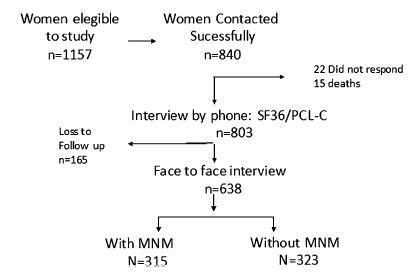Revista Brasileira de Ginecologia e Obstetrícia. 09-01-2018;40(9):518-526

To assess the relationship between the use of psychoactive substances during pregnancy and the occurrence of severe maternal morbidity (SMM), perinatal outcomes and repercussions on the neuropsychomotor development of exposed children.
A case-control study nested within a cohort of severe maternal morbidity (COMMAG) was performed. Women with SMM were considered cases. Controls were thosewith low-risk pregnancy,without SMMand admitted during the same time period as the cases. Cohort data were collected retrospectively in hospital records for childbirth. A face-to-face interview was also performed with 638 women (323 without SMM and 315 with SMM) and their children of the index pregnancy between 6 months and 5 years after childbirth. During the interview, substance abuse during pregnancy was assessed by a modified question from the Alcohol, Smoking and Substance Involvement Screening Test 2.0 (ASSIST) and the neuropsychomotor development in the children was assessed by the Denver Developmental Screening Test, 2nd edition.
The prevalence of licit or illicit drug use during pregnancy was ~ 17%. Among drug users, 63.9% used alcohol, 58.3% used tobacco, 9.2% used cocaine/crack and 4.6% used marijuana. There was no association between drug use during pregnancy and SMM, although tobacco use during pregnancy was associated with bleeding, presence of near-miss clinical criteria (NMCC) and alteration in infant development; alcohol use was associated with neonatal asphyxia; and cocaine/crack use was associated with the occurrence of some clinical complications during pregnancy.
The use of psychoactive substances during pregnancy is frequent and associated with worse maternal, perinatal and child development outcomes.
Search
Search in:


Comments